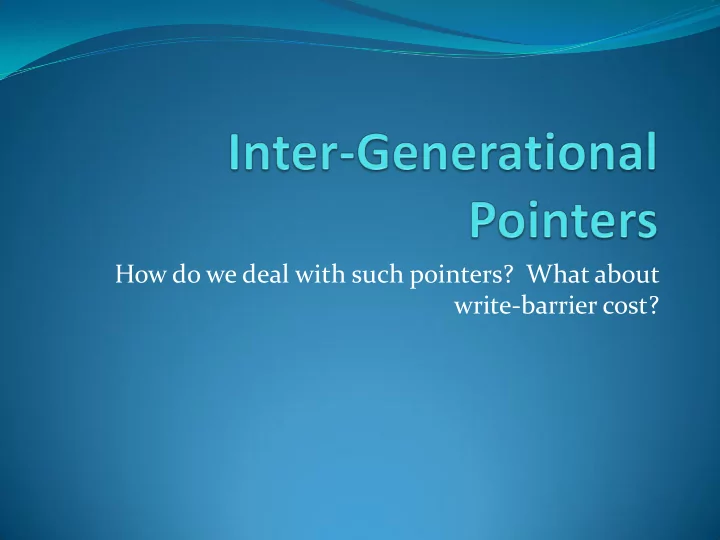

How do we deal with such pointers? What about write-barrier cost?
Inter-generational ptrs Generational collectors reduce pause time: They collecting only a region of the heap The only reference to an object in this region may be A ptr from outside the region An inter-generational ptr. Must be identified and treated as part of root set Whose responsibility? 2
Identifying inter-generational ptrs Simplest approach: Scan older-generation at collection time Introduces no cost to mutator, but Requires more scanning Has terrible locality of reference Start at roots and follow their objects for inter-generational ptrs More precise methods for recording them? 3
Write-barrier usage Recall Inter-generational ptrs arise in two ways Promotion of objects to old generation - detected by collector Pointer stores – How do we detect and record? Scan older generations? Use a write-barrier Write-barrier: Interception of writes to certain memory locations by mutator Implemented in Hardware; Software; OS support 4
Hardware write-barrier Requires no additional instructions Advantageous in presence of uncooperative compilers Requires special-purpose hardware Modifications to virtual-memory systems not always readily available 5
Software write-barrier Have compiler emit a few instructions before each ptr read or write Implementers must consider these factors: Minimization of cost to mutator Space overhead of recording ptr writes Efficiency of identifying old-young ptrs at collection time Do we inline the write-barrier code? 6
OS supported write-barrier Uses virtual memory protection mechanism To trap access to protected pages Use virtual memory page modification dirty bits As map of locations of objects with updated ptr fields Advantage of using virtual memory It is portable Requires no changes to compiler 7
Which pointer writes trap Writes that may not need to be trapped Stores to registers Stores to stack Initializing stores Not easy to detect in many languages These stores form the majority of pointer stores Stores that should be trapped Non-initializing stores ~ 1 % of instructions generated by Lisp or ML compilers 8
Trapping & recording inter-gen ptrs Entry tables Remembered sets Sequential store buffer Page marking with hardware support Page marking with virtual memory support Card marking 9
Entry tables First generational collector [implemented by Liberman & Hewitt , 1983] Made objects from old gen to point indirectly to objects in young gen Each gen had an entry table of refs from older gen to younger gen Storing pointer to young gen object from old gen object resulted in adding new entry to young gen’s entry table If old object already contains ref to item in entry table, that entry was removed 10
Entry table example Generation 2 Generation 1 Generation 0 11
Effects of using entry table Advantages: When collecting young generation, No need to search every older generation Only scan its entry table Disadvantages: Indirection scheme Table may contain duplicate references for single object Cost α # store operations vs # inter-gen ptrs Most modern gen collectors avoid indirection They record location of ptrs instead 12
Remembered sets Ungar’s Generational Scavenging Collector Records objects that point to younger generations Write-barrier implemented in software It intercepts stores to check Whether pointer was being stored Whether ref to young object stored in old object Address of such object added to remembered set Object has bit in header to indicate if already in remembered set 13
Remembered set example Old Generation Young Generation Remembered set 14
Effects of using remembered set Advantages: Scanning costs at collection time dependent on # remembered set objects, not number of pointers Disadvantages: Cost of store checking is high If multiple ptrs written into old object between collections , checks would be repeated Object would be scanned in its entirety at collection time Why? 15
Reducing scanning cost Remember location of ptr in object in remembered set Problems: Increase size of remembered set Multiple entries for large objects if large objects have multiple ptrs modified Approaches to reduce write-barrier costs while limiting space & time overhead Use vector of address for stored into object If overflow add more space or run GC GC filters the list of objects that meet certain requirements 16
Recommend
More recommend